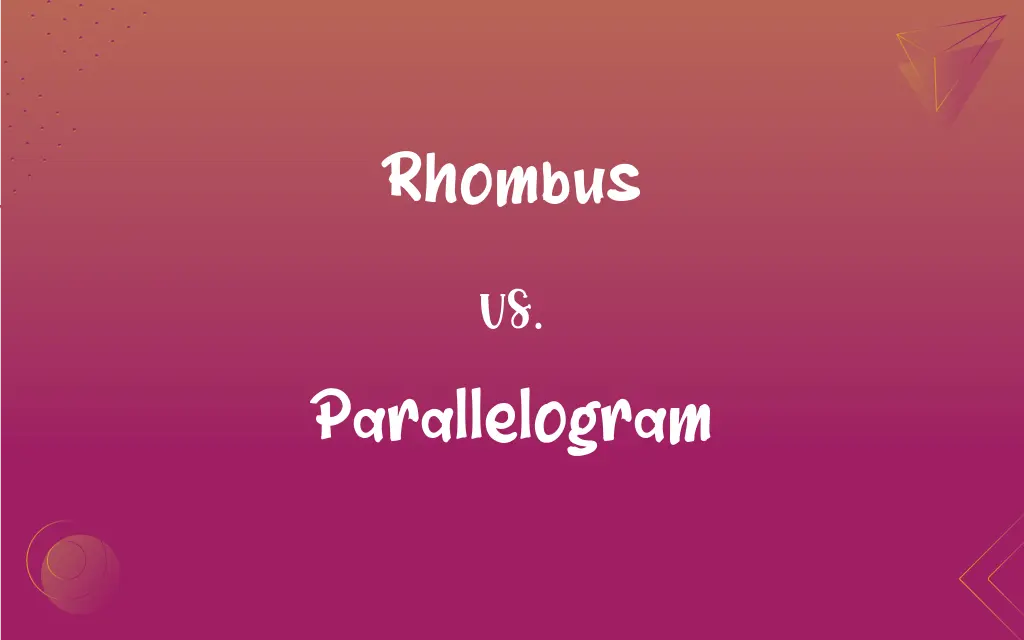Rhombus vs. Parallelogram: What's the Difference?
By Aimie Carlson & Harlon Moss || Updated on June 7, 2024
Rhombus is a quadrilateral with all sides equal and opposite angles equal. Parallelogram is a quadrilateral with opposite sides parallel and equal.

Key Differences
A rhombus stands out in the family of quadrilaterals as it is characterized by having all four of its sides of equal length. In contrast, a parallelogram is a quadrilateral where opposite sides are parallel and equal in length, without a necessity for all sides to be equal. This characteristic difference highlights that while every rhombus is a parallelogram (due to its opposite equal and parallel sides), not every parallelogram is a rhombus, clearly distinguishing their defining features.
While considering angles, a rhombus doesn’t always guarantee right angles, but it assures that opposite angles are equal. On the other side, a parallelogram ensures that adjacent angles are supplementary (adding up to 180 degrees) and opposite angles are equal, providing a geometrical distinction between the two in terms of their interior angular properties, showing that a parallelogram might sometimes encompass right angles, becoming a rectangle.
In terms of diagonals, a rhombus possesses diagonals that are always perpendicular bisectors of each other and are not necessarily equal. However, a parallelogram shows a different behavior in which its diagonals bisect each other but are not necessarily perpendicular or equal, reflecting a clear differential aspect between the two quadrilaterals.
Diving into symmetry, a rhombus always showcases rotational symmetry of order two, implying it appears identical after a rotation of 180 degrees. Contrarily, a parallelogram demonstrates line symmetry (or reflection symmetry) but does not guarantee rotational symmetry, giving an extra layer to their contrasting natures.
Focusing on area calculations, both the rhombus and parallelogram utilize base and height in their formulas. Specifically, a rhombus multiplies its diagonals and then divides by two, while a parallelogram multiplies its base by its height. This distinction in formula application is pivotal for students and professionals in using these shapes effectively in geometrical computations and real-world applications.
ADVERTISEMENT
Comparison Chart
Definition
All sides are equal
Opposite sides are equal and parallel
Angles
Opposite angles are equal
Opposite angles are equal
Diagonals
Perpendicular bisectors and not necessarily equal
Bisect each other, not necessarily perpendicular
Symmetry
Has rotational symmetry of order two
Has at least one line of symmetry
Area Calculation Formula
(Diagonal1 × Diagonal2) / 2
Base × Height
ADVERTISEMENT
Rhombus and Parallelogram Definitions
Rhombus
In a rhombus, opposite angles are equal, providing symmetry.
The rhombus displayed equal angles opposite to each other.
Parallelogram
A parallelogram has its opposite sides parallel and equal.
The parallelogram showed equal and parallel opposite sides.
Rhombus
The diagonals of a rhombus bisect each other at right angles.
The diagonals of the rhombus intersected perpendicularly.
Parallelogram
In a parallelogram, opposite angles are always equal.
The parallelogram exhibited equal angles across from each other.
Rhombus
A rhombus has a rotational symmetry of order two.
Rotating the rhombus 180 degrees yielded the same shape.
Parallelogram
The diagonals of a parallelogram bisect each other.
Diagonals of the parallelogram intersected, dividing each other in half.
Rhombus
The area of a rhombus is half the product of its diagonals.
Calculating area of the rhombus used the diagonal lengths.
Parallelogram
A parallelogram has at least one line of symmetry.
This parallelogram exhibited symmetry along its longer diagonal.
Rhombus
A rhombus is a four-sided figure with all sides of equal length.
The diamond shape in playing cards is a rhombus.
Parallelogram
The area of a parallelogram is obtained by multiplying its base and height.
We used the base and height to find the area of the parallelogram.
Rhombus
An equilateral parallelogram, especially one having oblique angles. Also called rhomb.
Parallelogram
Either of two rectangular areas (respectively the large parallelogram and the small parallelogram) abutting the goal line in front of the goal. (Since 1986 officially named the large rectangle and small rectangle, though the older names are still occasionally used.)
Rhombus
(geometry) A parallelogram having all sides of equal length.
Parallelogram
A right-lined quadrilateral figure, whose opposite sides are parallel, and consequently equal; - sometimes restricted in popular usage to a rectangle, or quadrilateral figure which is longer than it is broad, and with right angles.
Parallelogram
A four-sided plane figure with opposite sides parallel.
Parallelogram
(geometry) A convex quadrilateral in which each pair of opposite edges are parallel and of equal length.
Parallelogram
A quadrilateral whose opposite sides are both parallel and equal in length
FAQs
How do the diagonals of a parallelogram behave?
The diagonals of a parallelogram bisect each other but are not necessarily perpendicular or equal.
What defines a parallelogram?
A parallelogram is a quadrilateral where opposite sides are equal and parallel.
Is a square a special case of a parallelogram?
Yes, a square is a special type of parallelogram where all sides and angles are equal.
Do all rhombi have congruent diagonals?
No, a rhombus may have non-congruent diagonals that are perpendicular bisectors.
How is the area of a parallelogram determined?
The area of a parallelogram is found by multiplying its base and height: A = base * height.
Can a parallelogram be a rhombus?
A parallelogram can be a rhombus if all its sides are of equal length.
Do all parallelograms have congruent diagonals?
No, parallelograms do not necessarily have congruent diagonals.
How do angles behave in a rhombus?
In a rhombus, opposite angles are equal, and adjacent angles are supplementary.
How do angles behave in a parallelogram?
In a parallelogram, opposite angles are equal, and adjacent angles are supplementary.
What is a rhombus?
A rhombus is a quadrilateral with all sides equal in length and opposite angles equal.
How do the diagonals of a rhombus behave?
The diagonals of a rhombus are perpendicular bisectors of each other and may be unequal.
Can a rhombus be a parallelogram?
Yes, since a rhombus has opposite sides parallel and equal, it is a type of parallelogram.
What is the perimeter of a rhombus?
The perimeter of a rhombus is four times the length of one side (P = 4s).
How can we calculate the area of a rhombus?
The area of a rhombus is calculated as half the product of its diagonals: (d1 * d2) / 2.
What type of symmetry does a parallelogram have?
A parallelogram has at least one line of symmetry.
Is a square a special case of a rhombus?
Yes, a square is a special case of a rhombus where all angles are right angles.
What type of symmetry does a rhombus have?
A rhombus has rotational symmetry of order two.
About Author
Written by
Aimie CarlsonAimie Carlson, holding a master's degree in English literature, is a fervent English language enthusiast. She lends her writing talents to Difference Wiki, a prominent website that specializes in comparisons, offering readers insightful analyses that both captivate and inform.
Co-written by
Harlon MossHarlon is a seasoned quality moderator and accomplished content writer for Difference Wiki. An alumnus of the prestigious University of California, he earned his degree in Computer Science. Leveraging his academic background, Harlon brings a meticulous and informed perspective to his work, ensuring content accuracy and excellence.































































